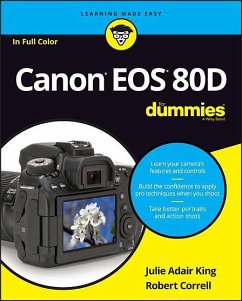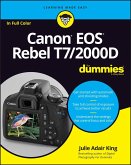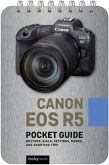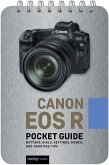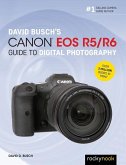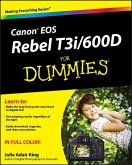33,99 €
inkl. MwSt.
**Unverbindliche Preisempfehlung des Herstellers
Versandkostenfrei*Versandfertig in 2-4 Wochen

17 °P sammeln
- Broschiertes Buch
- Merkliste
- Auf die Merkliste
- Bewerten Bewerten
- Teilen
- Produkt teilen
- Produkterinnerung
- Produkterinnerung
Take professional-quality photos with your Canon EOS 80D Your Canon EOS 80D gives you pro-level photo power. All you need is some know-how about your camera's capabilities and a little experience to start capturing brag-worthy photos and the expert tips and tricks inside get you there in a flash.
Andere Kunden interessierten sich auch für
![Canon EOS Rebel T7/2000d for Dummies Canon EOS Rebel T7/2000d for Dummies]() Julie Adair King (Indiana Indianapolis)Canon EOS Rebel T7/2000d for Dummies30,99 €
Julie Adair King (Indiana Indianapolis)Canon EOS Rebel T7/2000d for Dummies30,99 €![Canon EOS R5: Pocket Guide Canon EOS R5: Pocket Guide]() Rocky NookCanon EOS R5: Pocket Guide20,99 €
Rocky NookCanon EOS R5: Pocket Guide20,99 €![Canon EOS R: Pocket Guide Canon EOS R: Pocket Guide]() Rocky NookCanon EOS R: Pocket Guide20,99 €
Rocky NookCanon EOS R: Pocket Guide20,99 €![David Busch's Canon EOS R5/R6 Guide to Digital Photography David Busch's Canon EOS R5/R6 Guide to Digital Photography]() David BuschDavid Busch's Canon EOS R5/R6 Guide to Digital Photography46,99 €
David BuschDavid Busch's Canon EOS R5/R6 Guide to Digital Photography46,99 €![Canon EOS Rebel T3i / 600d for Dummies Canon EOS Rebel T3i / 600d for Dummies]() Julie Adair King (Indiana Indianapolis)Canon EOS Rebel T3i / 600d for Dummies29,99 €
Julie Adair King (Indiana Indianapolis)Canon EOS Rebel T3i / 600d for Dummies29,99 €![Canon EOS 90d for Dummies Canon EOS 90d for Dummies]() Robert CorrellCanon EOS 90d for Dummies33,99 €
Robert CorrellCanon EOS 90d for Dummies33,99 €![David Busch's Canon EOS 5d Mark IV Guide to Digital SLR Photography David Busch's Canon EOS 5d Mark IV Guide to Digital SLR Photography]() David D. BuschDavid Busch's Canon EOS 5d Mark IV Guide to Digital SLR Photography32,99 €
David D. BuschDavid Busch's Canon EOS 5d Mark IV Guide to Digital SLR Photography32,99 €-
-
-
Take professional-quality photos with your Canon EOS 80D Your Canon EOS 80D gives you pro-level photo power. All you need is some know-how about your camera's capabilities and a little experience to start capturing brag-worthy photos and the expert tips and tricks inside get you there in a flash.
Hinweis: Dieser Artikel kann nur an eine deutsche Lieferadresse ausgeliefert werden.
Hinweis: Dieser Artikel kann nur an eine deutsche Lieferadresse ausgeliefert werden.
Produktdetails
- Produktdetails
- Verlag: John Wiley & Sons Inc
- Seitenzahl: 352
- Erscheinungstermin: 25. Juli 2016
- Englisch
- Abmessung: 231mm x 189mm x 20mm
- Gewicht: 712g
- ISBN-13: 9781119291367
- ISBN-10: 1119291364
- Artikelnr.: 45161895
- Herstellerkennzeichnung
- Libri GmbH
- Europaallee 1
- 36244 Bad Hersfeld
- gpsr@libri.de
- Verlag: John Wiley & Sons Inc
- Seitenzahl: 352
- Erscheinungstermin: 25. Juli 2016
- Englisch
- Abmessung: 231mm x 189mm x 20mm
- Gewicht: 712g
- ISBN-13: 9781119291367
- ISBN-10: 1119291364
- Artikelnr.: 45161895
- Herstellerkennzeichnung
- Libri GmbH
- Europaallee 1
- 36244 Bad Hersfeld
- gpsr@libri.de
Julie Adair King is a veteran digital photography educator. Her best selling books include Digital Photography For Dummies and thirty titles on Canon and Nikon cameras. Robert Correll is a digital media expert who authored Digital SLR Photography All-in-One For Dummies.
Introduction 1
A Quick Look at What's Ahead 2
Icons and Other Stuff to Note 3
eCheat Sheet 3
Practice, Be Patient, and Have Fun! 4
Part 1: Fast Track to Super Snaps 5
Chapter 1: Getting the Lay of the Land 7
Looking at Lenses 7
Choosing a lens 8
Attaching and removing a lens 11
Zooming in and out 12
Using an IS (image stabilizer) lens 13
Getting acquainted with focusing 14
Adjusting the Viewfinder 15
Adjusting the Monitor Position 16
Using the Touchscreen 17
Working with Memory Cards 20
Exploring External Camera Features 22
Topside controls 22
Back-of-the-body controls 24
Front odds and ends 27
Connection ports 29
Ordering from Camera Menus 30
Navigating the Custom Functions Menu 32
Monitoring Critical Camera Settings 34
The Info button: Choosing what the screen shows 35
Checking the Camera Settings display 36
Viewing the Shooting Settings display 37
Decoding viewfinder data 38
Reading the LCD panel 40
Changing Settings via the Quick Control Screen 41
Getting Help from Your Camera 43
Reviewing Basic Setup Options 43
Cruising the Setup menus 43
Setting up the Lock switch 49
Taking two final setup steps 50
Chapter 2: Choosing Basic Picture Settings 51
Choosing an Exposure Mode 52
Changing the Drive Mode 54
Getting Familiar with the Built-in Flash 57
Using flash in the fully automatic modes 58
Enabling flash in advanced exposure modes 60
Using Red-Eye Reduction flash 60
Controlling Picture Quality 61
Diagnosing quality problems 62
Decoding the Image Quality options 64
Considering Resolution: Large, Medium, or Small? 66
Understanding File Type (JPEG or Raw) 69
JPEG: The imaging (and web) standard 69
Raw (CR2): The purist's choice 71
Our take: Choose Fine or Raw 73
Setting the Photo Aspect Ratio 73
Chapter 3: Taking Great Pictures, Automatically 75
As Easy As It Gets: Auto and Flash Off 76
Taking Advantage of Scene (SCN) Modes 79
Modifying scene mode results 88
Gaining More Control with Creative Auto 94
Chapter 4: Exploring Live View Shooting and Movie Making 99
Getting Started 100
Reviewing Live View and Movie mode cautions 102
Customizing the display 103
Focusing in Live View and Movie Modes 107
Continuous autofocusing in Movie mode 107
Choosing an AF (autofocus) mode 109
Manual focusing 114
Zooming in for a focus check 115
Exploring Other Live View Options 116
Adjusting other Live View picture settings 116
Using the touch shutter 122
Recording Your First Movie 123
Customizing Movie Recording Settings 126
Shooting Menu 4 (Movie) 128
Shooting Menu 5 (Movie) 129
Using Movie Digital Zoom 134
Playing Movies 136
Part 2: Working with Picture Files 139
Chapter 5: Picture Playback 141
Disabling and Adjusting Image Review 141
Exploring Playback Mode 142
Switching to Index (thumbnails) view 143
Using the Quick Control screen during playback 145
Jumping through images 146
Rotating pictures 149
Zooming in for a closer view 150
Viewing Picture Data 151
Basic Information display data 152
Shooting Information display mode 153
Understanding histograms 157
Enabling a few display extras 159
Deleting Photos 159
Erasing single images 159
Erasing all images on the memory card 160
Erasing selected images 160
Protecting Photos 162
Protecting (or unprotecting) a single photo 162
Protecting multiple photos 163
Rating Photos 165
Viewing Your Photos on a Television 167
Chapter 6: Downloading, Printing, and Sharing Your Photos 169
Installing the Canon Software 170
Sending Pictures to the Computer 171
Connecting camera and computer via USB 172
Connecting to the computer via Wi-Fi 173
Downloading from the camera 176
Downloading from a card reader 178
Processing Raw (CR2) Files 178
Processing Raw images in the camera 179
Converting Raw images in Digital Photo Professional 182
Planning for Perfect Prints 185
Preparing Pictures for Online Sharing 186
Part 3: Taking Creative Control 189
Chapter 7: Getting Creative with Exposure 191
Kicking Your Camera into High Gear 192
Introducing Exposure Basics: Aperture, Shutter Speed, and ISO 193
Understanding exposure-setting side effects 195
Doing the exposure balancing act 199
Monitoring Exposure Settings 200
Choosing an Exposure Metering Mode 203
Setting ISO, f-stop, and Shutter Speed 206
Controlling ISO 206
Adjusting aperture and shutter speed 209
Sorting through Your Camera's Exposure-Correction Tools 212
Overriding autoexposure results with Exposure Compensation 212
Improving high-contrast shots 216
Experimenting with Auto Lighting Optimizer 221
Correcting vignetting with Peripheral Illumination Correction 223
Dampening noise 225
Locking Autoexposure Settings 227
Bracketing Exposures Automatically 229
Setting up for automatic bracketing 230
Shooting a bracketed series 232
Using Flash in Advanced Exposure Modes 233
Understanding your camera's approach to flash 234
Using flash outdoors 237
Adjusting flash power with Flash Exposure Compensation 238
Locking the flash exposure 240
Exploring more flash options 242
Chapter 8: Manipulating Focus and Color 245
Reviewing Focus Basics 246
Introducing the AF-ON button 247
Adjusting Autofocus Performance 248
AF Area mode: One focus point or many? 249
Changing the AF (autofocus) operation mode 252
Choosing the right autofocus combo 254
Manipulating Depth of Field 254
Controlling Color 259
Correcting colors with white balance 259
Changing the White Balance setting 261
Creating a custom White Balance setting 263
Fine-tuning White Balance settings 265
Bracketing shots with white balance 269
Taking a Quick Look at Picture Styles 273
Chapter 9: Putting It All Together 279
Recapping Basic Picture Settings 279
Setting Up for Specific Scenes 282
Shooting still portraits 282
Capturing action 287
Capturing scenic vistas 291
Capturing dynamic close-ups 293
Part 4: the Part of Tens 297
Chapter 10: Ten Features to Explore on a Rainy Day 299
Enabling Mirror Lockup Shooting 300
Adding Cleaning Instructions to Images 300
Tagging Files with Your Copyright Claim 301
Exploring Wi-Fi Functions 302
Experimenting with Creative Filters 304
Shooting in Multiple Exposure Mode 307
Investigating Two More Printing Options 308
Presenting a Slide Show 309
Editing Movies 309
Creating Video Snapshots and Time Lapse Movies 310
Chapter 11: Ten More Ways to Customize Your Camera 313
Creating Your Own Exposure Modes 314
Creating Your Very Own Camera Menu 315
Creating Custom Folders 318
Changing the Color Space from sRGB to Adobe RGB 318
Changing the Direction of the Dials 319
Changing All the Furniture Around 319
Disabling the AF-Assist Beam 321
Controlling the Lens Focus Drive 322
Making the Flashing Red AF Points Go Away 323
Considering a Few Other Autofocusing Tweaks 323
Index 327
A Quick Look at What's Ahead 2
Icons and Other Stuff to Note 3
eCheat Sheet 3
Practice, Be Patient, and Have Fun! 4
Part 1: Fast Track to Super Snaps 5
Chapter 1: Getting the Lay of the Land 7
Looking at Lenses 7
Choosing a lens 8
Attaching and removing a lens 11
Zooming in and out 12
Using an IS (image stabilizer) lens 13
Getting acquainted with focusing 14
Adjusting the Viewfinder 15
Adjusting the Monitor Position 16
Using the Touchscreen 17
Working with Memory Cards 20
Exploring External Camera Features 22
Topside controls 22
Back-of-the-body controls 24
Front odds and ends 27
Connection ports 29
Ordering from Camera Menus 30
Navigating the Custom Functions Menu 32
Monitoring Critical Camera Settings 34
The Info button: Choosing what the screen shows 35
Checking the Camera Settings display 36
Viewing the Shooting Settings display 37
Decoding viewfinder data 38
Reading the LCD panel 40
Changing Settings via the Quick Control Screen 41
Getting Help from Your Camera 43
Reviewing Basic Setup Options 43
Cruising the Setup menus 43
Setting up the Lock switch 49
Taking two final setup steps 50
Chapter 2: Choosing Basic Picture Settings 51
Choosing an Exposure Mode 52
Changing the Drive Mode 54
Getting Familiar with the Built-in Flash 57
Using flash in the fully automatic modes 58
Enabling flash in advanced exposure modes 60
Using Red-Eye Reduction flash 60
Controlling Picture Quality 61
Diagnosing quality problems 62
Decoding the Image Quality options 64
Considering Resolution: Large, Medium, or Small? 66
Understanding File Type (JPEG or Raw) 69
JPEG: The imaging (and web) standard 69
Raw (CR2): The purist's choice 71
Our take: Choose Fine or Raw 73
Setting the Photo Aspect Ratio 73
Chapter 3: Taking Great Pictures, Automatically 75
As Easy As It Gets: Auto and Flash Off 76
Taking Advantage of Scene (SCN) Modes 79
Modifying scene mode results 88
Gaining More Control with Creative Auto 94
Chapter 4: Exploring Live View Shooting and Movie Making 99
Getting Started 100
Reviewing Live View and Movie mode cautions 102
Customizing the display 103
Focusing in Live View and Movie Modes 107
Continuous autofocusing in Movie mode 107
Choosing an AF (autofocus) mode 109
Manual focusing 114
Zooming in for a focus check 115
Exploring Other Live View Options 116
Adjusting other Live View picture settings 116
Using the touch shutter 122
Recording Your First Movie 123
Customizing Movie Recording Settings 126
Shooting Menu 4 (Movie) 128
Shooting Menu 5 (Movie) 129
Using Movie Digital Zoom 134
Playing Movies 136
Part 2: Working with Picture Files 139
Chapter 5: Picture Playback 141
Disabling and Adjusting Image Review 141
Exploring Playback Mode 142
Switching to Index (thumbnails) view 143
Using the Quick Control screen during playback 145
Jumping through images 146
Rotating pictures 149
Zooming in for a closer view 150
Viewing Picture Data 151
Basic Information display data 152
Shooting Information display mode 153
Understanding histograms 157
Enabling a few display extras 159
Deleting Photos 159
Erasing single images 159
Erasing all images on the memory card 160
Erasing selected images 160
Protecting Photos 162
Protecting (or unprotecting) a single photo 162
Protecting multiple photos 163
Rating Photos 165
Viewing Your Photos on a Television 167
Chapter 6: Downloading, Printing, and Sharing Your Photos 169
Installing the Canon Software 170
Sending Pictures to the Computer 171
Connecting camera and computer via USB 172
Connecting to the computer via Wi-Fi 173
Downloading from the camera 176
Downloading from a card reader 178
Processing Raw (CR2) Files 178
Processing Raw images in the camera 179
Converting Raw images in Digital Photo Professional 182
Planning for Perfect Prints 185
Preparing Pictures for Online Sharing 186
Part 3: Taking Creative Control 189
Chapter 7: Getting Creative with Exposure 191
Kicking Your Camera into High Gear 192
Introducing Exposure Basics: Aperture, Shutter Speed, and ISO 193
Understanding exposure-setting side effects 195
Doing the exposure balancing act 199
Monitoring Exposure Settings 200
Choosing an Exposure Metering Mode 203
Setting ISO, f-stop, and Shutter Speed 206
Controlling ISO 206
Adjusting aperture and shutter speed 209
Sorting through Your Camera's Exposure-Correction Tools 212
Overriding autoexposure results with Exposure Compensation 212
Improving high-contrast shots 216
Experimenting with Auto Lighting Optimizer 221
Correcting vignetting with Peripheral Illumination Correction 223
Dampening noise 225
Locking Autoexposure Settings 227
Bracketing Exposures Automatically 229
Setting up for automatic bracketing 230
Shooting a bracketed series 232
Using Flash in Advanced Exposure Modes 233
Understanding your camera's approach to flash 234
Using flash outdoors 237
Adjusting flash power with Flash Exposure Compensation 238
Locking the flash exposure 240
Exploring more flash options 242
Chapter 8: Manipulating Focus and Color 245
Reviewing Focus Basics 246
Introducing the AF-ON button 247
Adjusting Autofocus Performance 248
AF Area mode: One focus point or many? 249
Changing the AF (autofocus) operation mode 252
Choosing the right autofocus combo 254
Manipulating Depth of Field 254
Controlling Color 259
Correcting colors with white balance 259
Changing the White Balance setting 261
Creating a custom White Balance setting 263
Fine-tuning White Balance settings 265
Bracketing shots with white balance 269
Taking a Quick Look at Picture Styles 273
Chapter 9: Putting It All Together 279
Recapping Basic Picture Settings 279
Setting Up for Specific Scenes 282
Shooting still portraits 282
Capturing action 287
Capturing scenic vistas 291
Capturing dynamic close-ups 293
Part 4: the Part of Tens 297
Chapter 10: Ten Features to Explore on a Rainy Day 299
Enabling Mirror Lockup Shooting 300
Adding Cleaning Instructions to Images 300
Tagging Files with Your Copyright Claim 301
Exploring Wi-Fi Functions 302
Experimenting with Creative Filters 304
Shooting in Multiple Exposure Mode 307
Investigating Two More Printing Options 308
Presenting a Slide Show 309
Editing Movies 309
Creating Video Snapshots and Time Lapse Movies 310
Chapter 11: Ten More Ways to Customize Your Camera 313
Creating Your Own Exposure Modes 314
Creating Your Very Own Camera Menu 315
Creating Custom Folders 318
Changing the Color Space from sRGB to Adobe RGB 318
Changing the Direction of the Dials 319
Changing All the Furniture Around 319
Disabling the AF-Assist Beam 321
Controlling the Lens Focus Drive 322
Making the Flashing Red AF Points Go Away 323
Considering a Few Other Autofocusing Tweaks 323
Index 327
Introduction 1
A Quick Look at What's Ahead 2
Icons and Other Stuff to Note 3
eCheat Sheet 3
Practice, Be Patient, and Have Fun! 4
Part 1: Fast Track to Super Snaps 5
Chapter 1: Getting the Lay of the Land 7
Looking at Lenses 7
Choosing a lens 8
Attaching and removing a lens 11
Zooming in and out 12
Using an IS (image stabilizer) lens 13
Getting acquainted with focusing 14
Adjusting the Viewfinder 15
Adjusting the Monitor Position 16
Using the Touchscreen 17
Working with Memory Cards 20
Exploring External Camera Features 22
Topside controls 22
Back-of-the-body controls 24
Front odds and ends 27
Connection ports 29
Ordering from Camera Menus 30
Navigating the Custom Functions Menu 32
Monitoring Critical Camera Settings 34
The Info button: Choosing what the screen shows 35
Checking the Camera Settings display 36
Viewing the Shooting Settings display 37
Decoding viewfinder data 38
Reading the LCD panel 40
Changing Settings via the Quick Control Screen 41
Getting Help from Your Camera 43
Reviewing Basic Setup Options 43
Cruising the Setup menus 43
Setting up the Lock switch 49
Taking two final setup steps 50
Chapter 2: Choosing Basic Picture Settings 51
Choosing an Exposure Mode 52
Changing the Drive Mode 54
Getting Familiar with the Built-in Flash 57
Using flash in the fully automatic modes 58
Enabling flash in advanced exposure modes 60
Using Red-Eye Reduction flash 60
Controlling Picture Quality 61
Diagnosing quality problems 62
Decoding the Image Quality options 64
Considering Resolution: Large, Medium, or Small? 66
Understanding File Type (JPEG or Raw) 69
JPEG: The imaging (and web) standard 69
Raw (CR2): The purist's choice 71
Our take: Choose Fine or Raw 73
Setting the Photo Aspect Ratio 73
Chapter 3: Taking Great Pictures, Automatically 75
As Easy As It Gets: Auto and Flash Off 76
Taking Advantage of Scene (SCN) Modes 79
Modifying scene mode results 88
Gaining More Control with Creative Auto 94
Chapter 4: Exploring Live View Shooting and Movie Making 99
Getting Started 100
Reviewing Live View and Movie mode cautions 102
Customizing the display 103
Focusing in Live View and Movie Modes 107
Continuous autofocusing in Movie mode 107
Choosing an AF (autofocus) mode 109
Manual focusing 114
Zooming in for a focus check 115
Exploring Other Live View Options 116
Adjusting other Live View picture settings 116
Using the touch shutter 122
Recording Your First Movie 123
Customizing Movie Recording Settings 126
Shooting Menu 4 (Movie) 128
Shooting Menu 5 (Movie) 129
Using Movie Digital Zoom 134
Playing Movies 136
Part 2: Working with Picture Files 139
Chapter 5: Picture Playback 141
Disabling and Adjusting Image Review 141
Exploring Playback Mode 142
Switching to Index (thumbnails) view 143
Using the Quick Control screen during playback 145
Jumping through images 146
Rotating pictures 149
Zooming in for a closer view 150
Viewing Picture Data 151
Basic Information display data 152
Shooting Information display mode 153
Understanding histograms 157
Enabling a few display extras 159
Deleting Photos 159
Erasing single images 159
Erasing all images on the memory card 160
Erasing selected images 160
Protecting Photos 162
Protecting (or unprotecting) a single photo 162
Protecting multiple photos 163
Rating Photos 165
Viewing Your Photos on a Television 167
Chapter 6: Downloading, Printing, and Sharing Your Photos 169
Installing the Canon Software 170
Sending Pictures to the Computer 171
Connecting camera and computer via USB 172
Connecting to the computer via Wi-Fi 173
Downloading from the camera 176
Downloading from a card reader 178
Processing Raw (CR2) Files 178
Processing Raw images in the camera 179
Converting Raw images in Digital Photo Professional 182
Planning for Perfect Prints 185
Preparing Pictures for Online Sharing 186
Part 3: Taking Creative Control 189
Chapter 7: Getting Creative with Exposure 191
Kicking Your Camera into High Gear 192
Introducing Exposure Basics: Aperture, Shutter Speed, and ISO 193
Understanding exposure-setting side effects 195
Doing the exposure balancing act 199
Monitoring Exposure Settings 200
Choosing an Exposure Metering Mode 203
Setting ISO, f-stop, and Shutter Speed 206
Controlling ISO 206
Adjusting aperture and shutter speed 209
Sorting through Your Camera's Exposure-Correction Tools 212
Overriding autoexposure results with Exposure Compensation 212
Improving high-contrast shots 216
Experimenting with Auto Lighting Optimizer 221
Correcting vignetting with Peripheral Illumination Correction 223
Dampening noise 225
Locking Autoexposure Settings 227
Bracketing Exposures Automatically 229
Setting up for automatic bracketing 230
Shooting a bracketed series 232
Using Flash in Advanced Exposure Modes 233
Understanding your camera's approach to flash 234
Using flash outdoors 237
Adjusting flash power with Flash Exposure Compensation 238
Locking the flash exposure 240
Exploring more flash options 242
Chapter 8: Manipulating Focus and Color 245
Reviewing Focus Basics 246
Introducing the AF-ON button 247
Adjusting Autofocus Performance 248
AF Area mode: One focus point or many? 249
Changing the AF (autofocus) operation mode 252
Choosing the right autofocus combo 254
Manipulating Depth of Field 254
Controlling Color 259
Correcting colors with white balance 259
Changing the White Balance setting 261
Creating a custom White Balance setting 263
Fine-tuning White Balance settings 265
Bracketing shots with white balance 269
Taking a Quick Look at Picture Styles 273
Chapter 9: Putting It All Together 279
Recapping Basic Picture Settings 279
Setting Up for Specific Scenes 282
Shooting still portraits 282
Capturing action 287
Capturing scenic vistas 291
Capturing dynamic close-ups 293
Part 4: the Part of Tens 297
Chapter 10: Ten Features to Explore on a Rainy Day 299
Enabling Mirror Lockup Shooting 300
Adding Cleaning Instructions to Images 300
Tagging Files with Your Copyright Claim 301
Exploring Wi-Fi Functions 302
Experimenting with Creative Filters 304
Shooting in Multiple Exposure Mode 307
Investigating Two More Printing Options 308
Presenting a Slide Show 309
Editing Movies 309
Creating Video Snapshots and Time Lapse Movies 310
Chapter 11: Ten More Ways to Customize Your Camera 313
Creating Your Own Exposure Modes 314
Creating Your Very Own Camera Menu 315
Creating Custom Folders 318
Changing the Color Space from sRGB to Adobe RGB 318
Changing the Direction of the Dials 319
Changing All the Furniture Around 319
Disabling the AF-Assist Beam 321
Controlling the Lens Focus Drive 322
Making the Flashing Red AF Points Go Away 323
Considering a Few Other Autofocusing Tweaks 323
Index 327
A Quick Look at What's Ahead 2
Icons and Other Stuff to Note 3
eCheat Sheet 3
Practice, Be Patient, and Have Fun! 4
Part 1: Fast Track to Super Snaps 5
Chapter 1: Getting the Lay of the Land 7
Looking at Lenses 7
Choosing a lens 8
Attaching and removing a lens 11
Zooming in and out 12
Using an IS (image stabilizer) lens 13
Getting acquainted with focusing 14
Adjusting the Viewfinder 15
Adjusting the Monitor Position 16
Using the Touchscreen 17
Working with Memory Cards 20
Exploring External Camera Features 22
Topside controls 22
Back-of-the-body controls 24
Front odds and ends 27
Connection ports 29
Ordering from Camera Menus 30
Navigating the Custom Functions Menu 32
Monitoring Critical Camera Settings 34
The Info button: Choosing what the screen shows 35
Checking the Camera Settings display 36
Viewing the Shooting Settings display 37
Decoding viewfinder data 38
Reading the LCD panel 40
Changing Settings via the Quick Control Screen 41
Getting Help from Your Camera 43
Reviewing Basic Setup Options 43
Cruising the Setup menus 43
Setting up the Lock switch 49
Taking two final setup steps 50
Chapter 2: Choosing Basic Picture Settings 51
Choosing an Exposure Mode 52
Changing the Drive Mode 54
Getting Familiar with the Built-in Flash 57
Using flash in the fully automatic modes 58
Enabling flash in advanced exposure modes 60
Using Red-Eye Reduction flash 60
Controlling Picture Quality 61
Diagnosing quality problems 62
Decoding the Image Quality options 64
Considering Resolution: Large, Medium, or Small? 66
Understanding File Type (JPEG or Raw) 69
JPEG: The imaging (and web) standard 69
Raw (CR2): The purist's choice 71
Our take: Choose Fine or Raw 73
Setting the Photo Aspect Ratio 73
Chapter 3: Taking Great Pictures, Automatically 75
As Easy As It Gets: Auto and Flash Off 76
Taking Advantage of Scene (SCN) Modes 79
Modifying scene mode results 88
Gaining More Control with Creative Auto 94
Chapter 4: Exploring Live View Shooting and Movie Making 99
Getting Started 100
Reviewing Live View and Movie mode cautions 102
Customizing the display 103
Focusing in Live View and Movie Modes 107
Continuous autofocusing in Movie mode 107
Choosing an AF (autofocus) mode 109
Manual focusing 114
Zooming in for a focus check 115
Exploring Other Live View Options 116
Adjusting other Live View picture settings 116
Using the touch shutter 122
Recording Your First Movie 123
Customizing Movie Recording Settings 126
Shooting Menu 4 (Movie) 128
Shooting Menu 5 (Movie) 129
Using Movie Digital Zoom 134
Playing Movies 136
Part 2: Working with Picture Files 139
Chapter 5: Picture Playback 141
Disabling and Adjusting Image Review 141
Exploring Playback Mode 142
Switching to Index (thumbnails) view 143
Using the Quick Control screen during playback 145
Jumping through images 146
Rotating pictures 149
Zooming in for a closer view 150
Viewing Picture Data 151
Basic Information display data 152
Shooting Information display mode 153
Understanding histograms 157
Enabling a few display extras 159
Deleting Photos 159
Erasing single images 159
Erasing all images on the memory card 160
Erasing selected images 160
Protecting Photos 162
Protecting (or unprotecting) a single photo 162
Protecting multiple photos 163
Rating Photos 165
Viewing Your Photos on a Television 167
Chapter 6: Downloading, Printing, and Sharing Your Photos 169
Installing the Canon Software 170
Sending Pictures to the Computer 171
Connecting camera and computer via USB 172
Connecting to the computer via Wi-Fi 173
Downloading from the camera 176
Downloading from a card reader 178
Processing Raw (CR2) Files 178
Processing Raw images in the camera 179
Converting Raw images in Digital Photo Professional 182
Planning for Perfect Prints 185
Preparing Pictures for Online Sharing 186
Part 3: Taking Creative Control 189
Chapter 7: Getting Creative with Exposure 191
Kicking Your Camera into High Gear 192
Introducing Exposure Basics: Aperture, Shutter Speed, and ISO 193
Understanding exposure-setting side effects 195
Doing the exposure balancing act 199
Monitoring Exposure Settings 200
Choosing an Exposure Metering Mode 203
Setting ISO, f-stop, and Shutter Speed 206
Controlling ISO 206
Adjusting aperture and shutter speed 209
Sorting through Your Camera's Exposure-Correction Tools 212
Overriding autoexposure results with Exposure Compensation 212
Improving high-contrast shots 216
Experimenting with Auto Lighting Optimizer 221
Correcting vignetting with Peripheral Illumination Correction 223
Dampening noise 225
Locking Autoexposure Settings 227
Bracketing Exposures Automatically 229
Setting up for automatic bracketing 230
Shooting a bracketed series 232
Using Flash in Advanced Exposure Modes 233
Understanding your camera's approach to flash 234
Using flash outdoors 237
Adjusting flash power with Flash Exposure Compensation 238
Locking the flash exposure 240
Exploring more flash options 242
Chapter 8: Manipulating Focus and Color 245
Reviewing Focus Basics 246
Introducing the AF-ON button 247
Adjusting Autofocus Performance 248
AF Area mode: One focus point or many? 249
Changing the AF (autofocus) operation mode 252
Choosing the right autofocus combo 254
Manipulating Depth of Field 254
Controlling Color 259
Correcting colors with white balance 259
Changing the White Balance setting 261
Creating a custom White Balance setting 263
Fine-tuning White Balance settings 265
Bracketing shots with white balance 269
Taking a Quick Look at Picture Styles 273
Chapter 9: Putting It All Together 279
Recapping Basic Picture Settings 279
Setting Up for Specific Scenes 282
Shooting still portraits 282
Capturing action 287
Capturing scenic vistas 291
Capturing dynamic close-ups 293
Part 4: the Part of Tens 297
Chapter 10: Ten Features to Explore on a Rainy Day 299
Enabling Mirror Lockup Shooting 300
Adding Cleaning Instructions to Images 300
Tagging Files with Your Copyright Claim 301
Exploring Wi-Fi Functions 302
Experimenting with Creative Filters 304
Shooting in Multiple Exposure Mode 307
Investigating Two More Printing Options 308
Presenting a Slide Show 309
Editing Movies 309
Creating Video Snapshots and Time Lapse Movies 310
Chapter 11: Ten More Ways to Customize Your Camera 313
Creating Your Own Exposure Modes 314
Creating Your Very Own Camera Menu 315
Creating Custom Folders 318
Changing the Color Space from sRGB to Adobe RGB 318
Changing the Direction of the Dials 319
Changing All the Furniture Around 319
Disabling the AF-Assist Beam 321
Controlling the Lens Focus Drive 322
Making the Flashing Red AF Points Go Away 323
Considering a Few Other Autofocusing Tweaks 323
Index 327
